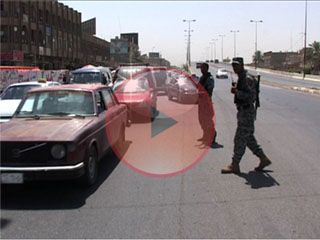Baghdad Security Plan Burdens Residents

Produced by Ali Al-Le'abiy and Nabeel Kamal
BAGHDAD, IRAQ– The ongoing fighting in Baghdad pushed the Iraqi and US forces to establish checkpoints all over the city to secure the roads and neighborhoods. Controlling the cars inside the city and preventing them from distributing weapons or bombs was the first aim of these checkpoints. There are four main types of checkpoints in Baghdad, the checkpoints made by US forces those of the Iraqi National Guard, and finally those established by the Iraqi Police or the Ministry of Interior.
There are approximately five hundred checkpoints deployed around the perimeter as well as inside the city. Most of the checkpoints are directed by the Iraqi National Guard or Coalition forces. These checkpoints are getting attacked repeatedly by IEDs, car bombs, and sniper attacks. Many Iraqis were killed because of these attacks, for example, they may be driving into a checkpoint or getting killed by stray bullets fired after a car bomb attack.
On the other hand, starting several years ago, militias began using what are known as fake checkpoints in order to kidnap or kill people. The fake checkpoints generated great fear among the Iraqi people agains Iraqi forces whether they were military forces or police. It become something very familiar within Iraqi society that if someone was kidnapped or disappeared at one of the fake checkpoints, the family should go and look in the morgue looking for that person.
Another type of checkpoint began appearing in late 2007, these ones have been run by the Sahwa “Awakening” Forces, in order to control the Sunni Areas and keep them out of Al-Qaeda control and free of any other groups that may be related to Al-Qaeda. These Sahwa Forces were selected from the same area they work in, their local knowledge helps them to know everyone coming in or out of neighborhood. These forces have assisted in establishing many of the stability gains in the Sunni neighborhoods.
The Iraqi security forces used to wear masks to hide their identity form other extremist insurgents, and not to be followed when they return home. Many militias also used masks to hide their faces and keep a low profile. In late 2007 the Iraqi government ordered all security forces to take off their masks to give a greater impression of honesty and trustworthiness to the Iraqi people and prevent them form being afraid due to the threat of fake checkpoints.
Today, although security appears to have returned to much of Baghdad, blast walls and checkpoints continue to choke the city streets. These measures helped re-establish security in the capital, but today many people question them and have begun pushing the Iraqi government to take down the walls that block much of the city.
archival reference: https://web.archive.org/web/20130706083046/http://aliveinbaghdad.org/2008/10/07/baghdad-security-plan-burdens-residents/
Editor's Note: The concept for Alive-in/ began in 2005 with the launch of Alive in Baghdad. Many of the stories produced by our team of Iraqi reporters were taken offline with the closure of blip.tv.
In remembrance of the 20th anniversary of the United States war against Iraq, we are republishing as much of Alive in Baghdad's original content as possible here on Alive-in/. Each story has been given its original date so that these posts don't overwhelm our current stories, and tagged as relevant.
